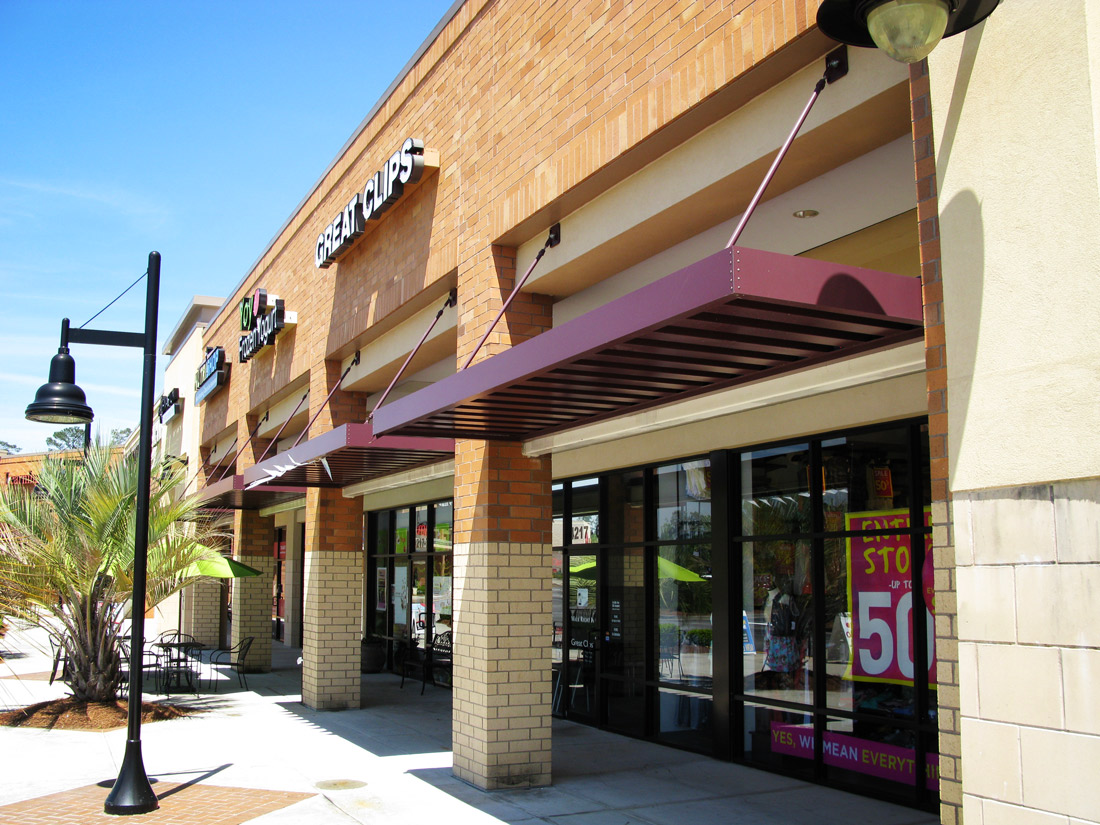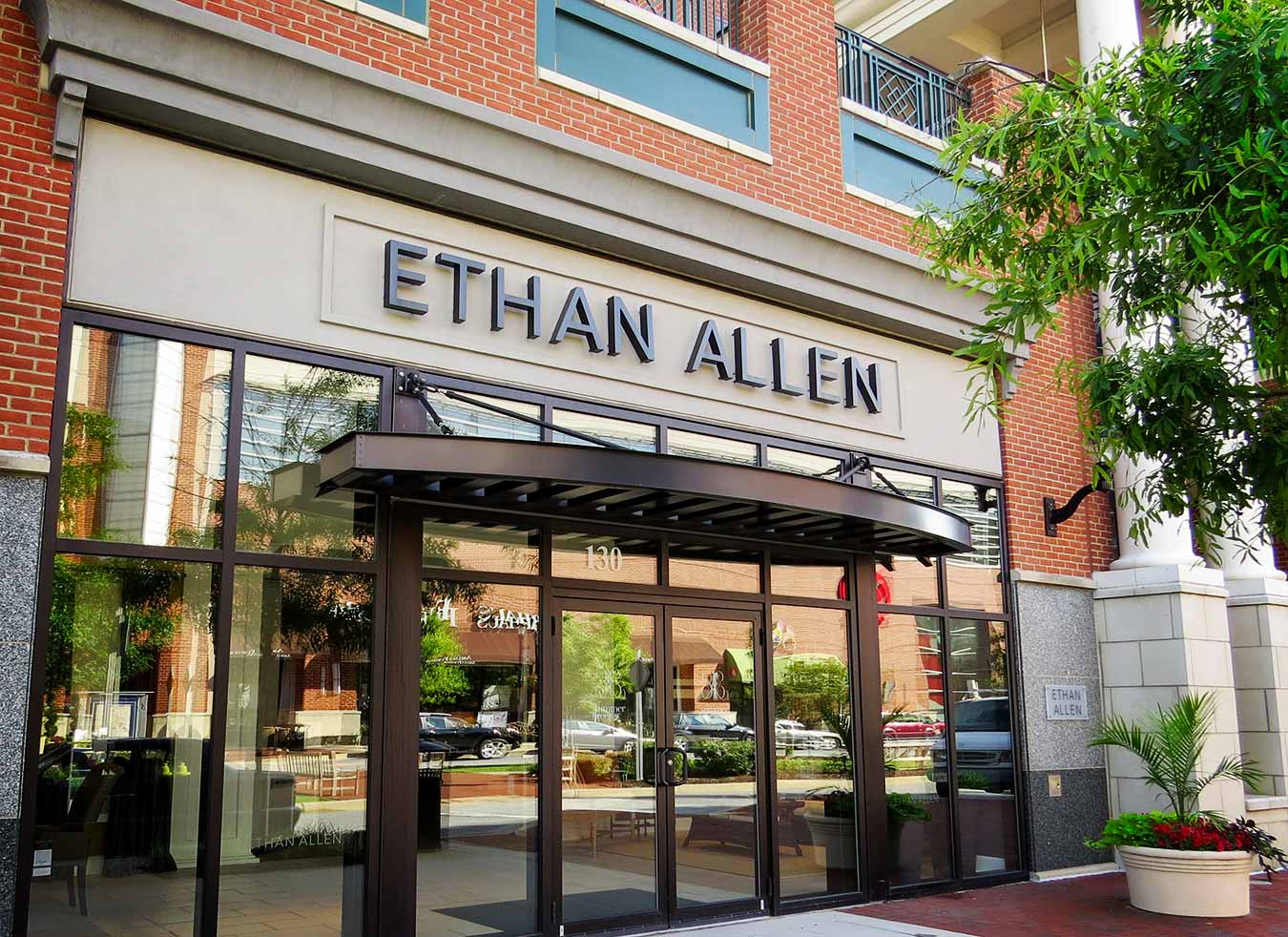Awning vs. Canopy: Which is Right for Your Project?

The finishing touches are what create signature design aesthetics and make buildings inviting spaces for the public. A critically important finishing touch for a commercial building design is a canopy or an awning. When choosing a canopy vs. awning, architects and builders should compare elements besides pure aesthetics like design, function, durability and branding.
Canopies and awnings may have similar functions, but the range of design options, strength, and other elements make the canopy vs. awning decision harder than you may think.
What Is an Awning?
An awning for a commercial building is a lightweight sheet metal or fabric-covered extension installed over windows, doors or outdoor areas to provide shade, weather protection and aesthetics to a building.
Awnings can help regulate indoor temperatures by reducing solar heat gain and improving energy efficiency. They also protect entrances and walkways from rain and snow, enhancing accessibility and safety.
For retail, restaurant and hospitality businesses, commercial awnings can also be used as branding elements that reinforce a business’ visual identity. Awnings are usually custom-designed to integrate seamlessly with a building’s architecture.
What Is a Canopy?

A building canopy is a permanent or semi-permanent overhead structure extending from a building’s facade or standing independently to provide shelter, shade and aesthetic appeal.
Designed to protect entrances, loading docks, walkways or outdoor gathering spaces, canopies shield against rain, snow and sun while enhancing a building’s functionality and aesthetic presence.
Constructed from materials like steel, aluminum, glass or tensile fabric, canopies can be customized to match architectural styles, meet local building codes and provide branding space for businesses. Canopies increase energy efficiency by reducing solar heat gain and can incorporate lighting, signage or drainage systems for added functionality.
Canopies can also direct people’s flow on a property, providing visual cues that guide people from a parking structure to a building or guiding people to the entrances and exits of a building.
Key Factors to Consider When Choosing Between Awnings and Canopies
When choosing between an awning or a canopy for your project, one isn’t necessarily “better” than the other. Canopies are the best choice for some projects while awnings are best for others. The factors that you should consider when you’re choosing a canopy vs. awning for a project are:
1. Functionality and Protection
Both canopies and awnings provide weather protection and enhance a building’s functionality. But they differ in scale, durability, and application.
Canopies are typically larger and more structurally robust. They can provide more coverage for entrances, loading areas and outdoor gathering spaces. The larger surface area also provides more shielding against rain, snow and sun.
Awnings, by contrast, are smaller and often made from a lightweight fabric that isn’t as durable as the aluminum canopy. They don’t offer the same widespread protection that canopies offer. Awnings can be more practical for buildings in tight spaces, but in general, canopies offer more functionality and protection.
2. Installation
When it comes to installation, awnings have a more straightforward approach. They are quick and easy to hang, saving on installation time and costs.
However, it’s important to note that awnings do require several secure mounting points and may not be feasible for all building facades, especially when retrofitting existing buildings. Plus, in tight urban environments, awnings may extend into pedestrian pathways and require additional clearance considerations.
As for canopies, they require specialized mounting systems, anchoring and assembling due to their increased weight. Although, with an experienced professional, installation can be easier and faster.
3. Aesthetic Appeal and Design
Aesthetically, canopies and awnings are very different. Canopies, especially aluminum canopies, are customizable with many different colors and can be precisely cut to fit a wide range of architectural styles ranging from clean, sophisticated and modern to edgy, industrial or even retro styles.
Awnings, on the other hand, are limited in the aesthetics available because of the materials they are made from. Awnings are a fantastic choice for projects where vintage charm, old-fashioned appeal or breezy coastal vibes are needed to blend all of the architectural elements.
4. Durability and Maintenance
Aluminum canopies are significantly more durable than fabric-based awnings. Canopies are the right choice for projects where long-term durability and low maintenance are priorities.
Constructed from corrosion-resistant aluminum or aluminum-framed systems, canopies withstand harsh weather conditions, including heavy rain, snow and high winds, without significant wear.
They require occasional cleaning and inspections for structural integrity but generally don’t need more than regular inspections and minor upkeep.
Awnings, which are often made from fabric or lightweight materials, are more susceptible to fading, tearing and weather-related damage. They require regular maintenance, including cleaning, tension adjustments and periodic fabric replacement, especially in high-exposure environments.
5. Cost Considerations
Awnings are initially more affordable than permanent structural additions while still offering practical benefits. For projects with a tight budget, awnings can be a smart way to create a cohesive finished look without exceeding the allotted budget.
However, because they are more susceptible to damage from the elements, their ongoing maintenance costs are higher. If replacement is needed, this will also be a significant expense for a building owner.
Meanwhile, aluminum canopies can have a higher upfront cost than awnings, but that can be offset by the lack of maintenance and the longevity of a canopy. It is essential to consider the upfront investment compared to the long-term value.
6. Regulatory Compliance and Obstruction Concerns
While awnings can contribute to LEED certification by improving building energy performance, their installation during construction may require permits and inspections to meet local zoning, fire and safety regulations.
As for aluminum canopies, they meet fire safety regulations more easily than fabric alternatives and can contribute to LEED certification.
Depending on size and location, installing canopies on a commercial building may require permits and adherence to zoning and fire codes. Additionally, large canopies may extend into pedestrian pathways or vehicle clearance zones, so careful placement or design changes may be needed.
Awnings vs Canopies In Review
The considerations for awnings vs canopies can be overwhelming. Below, we’ve created a quick, all-encompassing chart to help explain which option performs better in specific categories.
Awnings vs Canopies Comparison Guide |
||
| Awning | Canopy | |
| Increased Durability | ✓ | |
| Less Maintenance | ✓ | |
| Structural Longevity | ✓ | |
| Enhanced Protection | ✓ | |
| Ease of Installation | ✓ | |
| Improve Energy Efficiency | ✓ | ✓ |
| Overall Design Appeal | ✓ | ✓ |
| Lower Initial Cost | ✓ | |
| Lower Long-Term Costs | ✓ | |
| Contributes to LEED Certification | ✓ | ✓ |
| Requires Zoning and Construction Permits | ✓ | ✓ |
Making The Right Choice With Mapes Canopies

Now that you know the pros and cons of both awnings and canopies, trust Mapes to help you choose the right solution for your project.
With many customization options and classic designs that fit any project, Mapes’ canopies can elevate any design and provide a beautiful and functional finishing touch to your project.
Discover our solutions today or get in touch with our team to discuss what canopy would be best for your project.
Back to All
